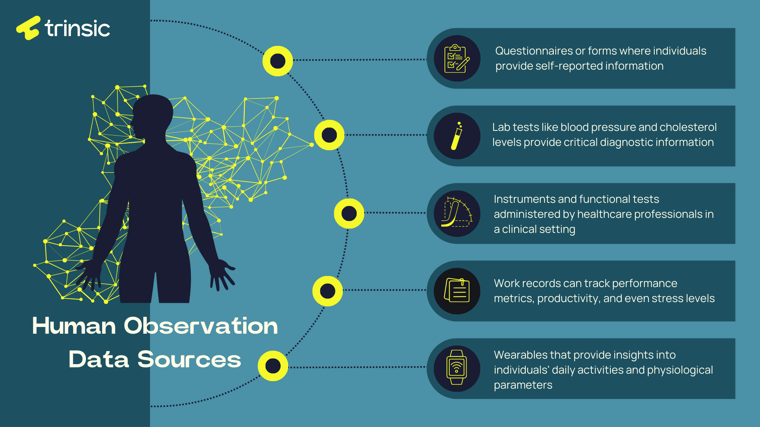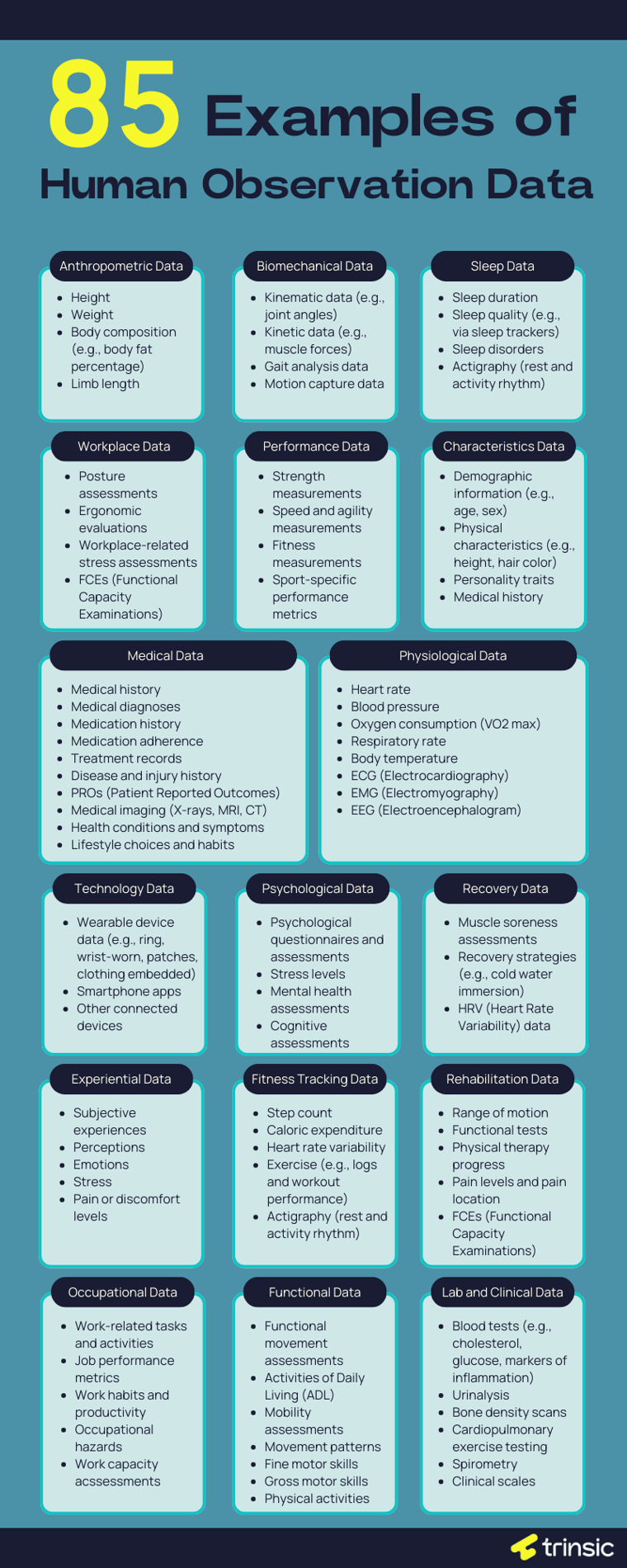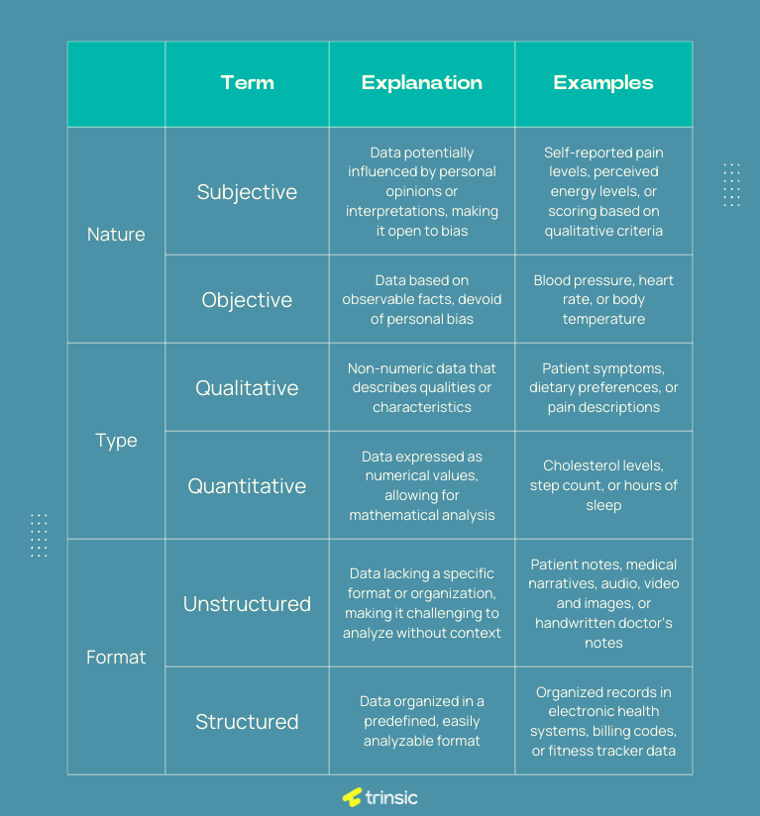What We'll Cover
- Defining human observation data and sources as a broad categorization.
- Various examples of human observation data and some ways they can be categorized.
- Introduce and compare different human observation data attributes, types, and formats.
Show me the Summary
We often think strictly of numbers, spreadsheets, and charts when discussing data. While this intuition isn't wrong, it is a bit dated. The term data has evolved significantly in the last 20 years, driven by technological advancements, changes in data usage, and shifts in our understanding and application of data. We now have the technology to gather and interpret human observation data, which has many implications health and wellness.
What once was scarce, static, and specific has matured to be abundant, dynamic, and comprehensive.
Technological advancements have made it more accessible and efficient to capture, store, process, and utilize data from a broad spectrum of sources, ultimately enabling us to turn most anything into "data."
The Maturation of Human Data
Human Data, or more precisely, Human Observation Data, is a broad data category defined as information collected through direct observation or assessment of human behaviors, actions, characteristics, responses, and experiences.
To be clear, human data is not limited to qualitative observations made in-person by researchers or clinicians visually observing people; it encompasses all information that may be collected directly from humans… again, related to behaviors, actions, characteristics, responses, and experiences. So, while a doctor can record a series of observations on a patient during a routine clinical examination, an Apple Watch can continuously record observations on that patient throughout the day (and night)!
All of this falls under the umbrella of human data.
Data Sources and Instrumentation
It is perhaps most intuitive to exemplify human data by referencing the many ways this is collected in the real world. Human data encompasses a diverse range of sources and methods, each designed to capture specific aspects of an individual's physical or behavioral attributes. These sources include traditional means such as lab tests and completing questionnaires or forms, where individuals provide self-reported information, as well as more clinically driven approaches involving instruments and functional tests administered by healthcare professionals in a clinical setting.
Beyond healthcare, human data can be derived from work records and wearables, providing insights into individuals' daily activities and physiological parameters. Collectively, these various sources contribute to a comprehensive understanding of human health, behaviors, and characteristics.

Human data has evolved more drastically than data in other domains due to exponential technological improvements in human-relevant data capture capabilities. Human data captured through technology isn't in-place-of data captured through in-person observation; it's in-addition-to.
It's not one or the other; it's both. It's more!
Human Observation Data Examples
The utility of human data is already widely apparent in various industries and domains. While we may think first of healthcare and human performance-driven organizations (e.g., military and sports), leveraging this data category is valuable for any organization that relies on or employs people.
Below is a long, and still not comprehensive, list of examples of human observation data. We attempted to include some categories and classifications. Still, ultimately, much of this data can be analyzed to answer a variety of different questions and operationalized to improve an equally broad range of real-world problems.

While there was no expectation for anyone to review this list in detail, the length and breadth above convey the abundance and variety of available human observation data. While the list above focuses mainly on examples of data, many of these things can be measured in various ways or using different instruments. Depending on the available resources, these data sources may be more objective or subjective. While the nature of the data collected is relevant for understanding what analysis and insights can be derived, it's not the only consideration.
More Data, More Details
Researchers often use the terms qualitative and quantitative, practitioners— subjective and objective, and data scientists— structured and unstructured.
Aren't these all the same, or are they? Why does it matter?
The table below provides some more explanations and examples, though forewarning may provoke thought more than provide answers. To address our last question above, for the sake of our discussion today, it doesn't matter much. The goal here is simply to introduce these terms. They are related, but there is nuance to how they apply to human observation data collection and analysis. Instead of presenting a detailed semantic discussion, we intend to highlight some prerequisite considerations necessary to best utilize this class of data.

After reviewing these, you may see some parallels between Subjective, Qualitative, and Unstructured, as well as between Objective, Quantitative, and Structured. There is no doubt some similarity, and these groupings will often be aligned.
Subjective data is often qualitative and unstructured, but not always.
For example, the Functional Movement Screen (FMS) and Balance Error Scoring System (BESS) are performed by trained practitioners who subjectively score users using quantitative scoring following a structured framework.
Objective data is often quantitative and structured, but not always.
Medical imaging data like MRIs and video are no doubt objectively capturing data but are qualitative and unstructured. Videos of patients performing rehabilitation exercises offer valuable qualitative insights into movement patterns, posture, function, and progress.
To muddy the waters even more, further combinations fall in between. For example, while the scores from a BESS test are quantitative and structured, the notes that a PT provides from their observations are qualitative and unstructured. Additionally, computer vision technology can extract structured data from rehabilitation videos. Let us welcome semi-structured and semi-quantitative to the conversation!
These examples provide a glimpse into the complexity of human observation data and some of the critical considerations necessary to turn this data into insights and information.
Take Home
- Human Observation Data is a broad data category defined as information collected through direct observation or assessment of human behaviors, actions, characteristics, responses, and experiences.
- Technological evolution evolved human observation data into a class of its own. Human Observation Data examples are everywhere.
- As this data becomes more abundant, dynamic, and comprehensive, some mounting considerations and complexities must be accounted for.